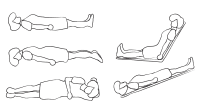Polypharmacy refers to the effects of taking multiple medications concurrently to manage coexisting health problems, such as diabetes and hypertension. Too often, polypharmacy becomes problematic, such as when patients are prescribed too many medications by multiple healthcare providers working independently of each other. Also, drug interactions can occur if no single healthcare provider knows the patient’s complete medication picture.
Among older adults, polypharmacy is a common problem. Currently, 44% of men and 57% of women older than age 65 take five or more medications per week; about 12% of both men and women take 10 or more medications per week. These agents include both prescription and over-the-counter (OTC) preparations, such as vitamin and mineral supplements and herbal products.
The most commonly used drugs—acetaminophen, ibuprofen, and aspirin—are available OTC and contribute significantly to adverse drug reactions in the elderly. Generally, the more drugs a person takes, the greater the risk of adverse reactions and drug interactions. The drug categories most commonly involved in adverse reactions are cardiovascular agents, antibiotics, diuretics, anticoagulants, hypoglycemics, steroids, opioids, anticholinergics, benzodiazepines, and nonsteroidal anti-inflammatory drugs.
Geriatric medication reconciliation in the home setting
Seven reversible causes of dementia in older adults
Implementing evidence-based practice in long-term care
Nurses have a unique opportunity to help identify patients at risk for inappropriate polypharmacy and to educate patients and families about risk reduction. This article explores potential problems related to multiple drug use in the elderly, including age-related alterations in response to drugs, drug-drug and drug-herbal interactions, and nonadherence with the medication regimen. It also identifies strategies to minimize these risks.
How aging affects response to drugs
Older persons react differently to medications than younger persons. Although absorption rates for most drugs don’t change with age, aging alters body fat and water composition: fat stores increase while total body water decreases. These changes can alter therapeutic drug levels, causing greater concentrations of water-soluble drugs and longer half-lives of fat-soluble drugs.
Also, because the liver metabolizes many drugs, such age-related changes as reduced hepatic blood flow and liver size alter drug clearance. Drug elimination also may be affected by age-related decreases in renal blood flow, kidney size, and glomerular filtration rates, as well as changes stemming from chronic diseases.
Additionally, digoxin and certain other drugs are bound to plasma proteins so that only the unbound or free portion of the drug is biologically active. Therefore, decreases in serum albumin levels—common in older adults with chronic illnesses, malnutrition, or severe debilitation—can lead to higher drug blood levels. Subsequently, older patients may be more sensitive to some drugs and less sensitive to others.
Adverse reactions to drugs
Adverse reactions are common in older adults and often manifest differently than in younger patients. An estimated 35% of ambulatory older adults experience an adverse drug reaction each year; 29% of these reactions require hospitalization or a physician’s care. What’s more, some adverse reactions are identified incorrectly as health problems. For instance, falls, dementia, and urinary incontinence are common in the elderly and can result from a health problem or a medication.
In a prescribing cascade, an adverse reaction to one drug goes unrecognized or misinterpreted, causing the healthcare provider to inappropriately subscribe a second drug to treat signs and symptoms. This can lead to potentially dangerous situations and overprescribing.
Dietary and herbal preparations
Dietary supplements (such as vitamin and mineral supplements) and herbal preparations have become popular. For instance, ginkgo biloba, St. John’s wort, echinacea, ginseng, garlic, saw palmetto, kava, and valerian root are promoted for their purported use in preventing or treating various health problems, including depression and the common cold. A person may start taking these preparations after hearing about them from friends, family, or the media. And because they’re available OTC, patients may not think they should mention them to healthcare providers. Yet these preparations can interact with prescribed medications and lead to serious adverse effects. So be sure to ask the patient about all preparations—not just prescription drugs—he or she is taking.
Poor adherence to the medication regimen
Poor adherence to the medication regimen is an ongoing problem among older adults. Although most patients are motivated to take their medications as prescribed, some may fail to comply due to lack of understanding, confusion, or simple forgetfulness. In other cases, prescribers may advise a patient to cut tablets in half to lower the dosage—but this task may be difficult or impossible for elderly patients with decreased vision or poor manual dexterity.
Also, some patients may attribute unpleasant symptoms to a medication and, without consulting the prescriber, decrease the dosage or even stop taking the drug. Those with visual deficits may have difficulty reading the prescription label. Patients with financial problems or who live on fixed incomes may decide to take lower-than-prescribed dosages to extend their supply—or they may not fill a prescription at all.
Nurse’s role
As a nurse, you can be pivotal in helping older patients manage their medications and prevent polypharmacy. The keys to reducing polypharmacy risks are information, instruction, and organization (summarized in the table below.)
| Reducing medication risks in older adults |
|---|
Here are strategies you can use to help patients reduce the risk of polypharmacy.Information. Discuss with patients the need to:
Instruction. Teach patients about:
Organization. To help patients manage their drugs, caution them to:
Also, if appropriate, help patients establish memory aids. For instance, advise patients to link drug administration to their daily routine or to use color-coded charts, automatic dispensers with bells, or voice-activated message services to remember to take their doses. |
Information includes discussing with patients the need to keep an accurate list of all medications (both prescription and OTC) they’re currently taking. Advise them to record the medication names (generic and brand), prescribed dosage and dosing frequency, and the reason it was prescribed. The sample template below can be useful for older patients.
Teach patients to take all medications to their medical appointments to verify they’re taking the right drugs. Often called a “brown bag” check, this is a good way to eliminate confusion over previously discontinued drugs or incorrect dosages. Inform patients of any dietary restrictions necessitated by a specific medication. During healthcare appointments, teach the patient about potential side effects, including when to call the clinic or go to the emergency room. This also gives you an opportunity to clear up any confusion caused by look-alike or sound-alike drug names or drugs with similar appearances. These face-to-face meetings are invaluable; as you establish a strong relationship with the patient, you can find out how the patient is actually taking the medications.
Instruction must be combined with good communication. Optimally, patient care should be directed by a limited number of healthcare providers. The primary-care provider and specialists must maintain good communication with each other to prevent or minimize problems. Advise patients to use only one pharmacy to obtain medications; this adds another level of review to help ensure appropriate dosage and reduce the risk of adverse drugs effects and interactions. Instruct patients to take medications as instructed and to inform their providers if health changes occur, especially after starting a new medication. Caution them not to stop taking a drug without consulting their healthcare provider. At each visit, ask patients about their adherence to the medication regimen and their use of OTC preparations.
Organization can improve adherence. Complex medication regimens are challenging even for the most diligent patients. Caution patients to take only those drugs prescribed for them and not to share medications with others or save them for future use. Teach them to store medications in a secure, dry location away from direct sunlight or to refrigerate them if needed. As appropriate, recommend use of 7-day pill boxes, daily pill boxes, or blister packs to help patients adhere to their regimen. Color-coded charts can help elderly patients set up pill boxes. For patients with cognitive deficits, recommend the use of drug dispensers with bells, automatic dispensers with voice-activated messages, and regular or video-telephone call reminders, as appropriate. Another basic technique to improve adherence is to link dosing schedules to routine activities of daily living, such as brushing the teeth, eating breakfast, or other activities that can serve as memory triggers.
Other ways to reduce medication problems
Where appropriate, healthcare providers should explore nonpharmacologic alternatives to drugs, such as dietary changes. However, know that underprescribing of effective therapies in older patients also is a concern. Healthcare providers must evaluate and balance a drug’s potential adverse effects against its potential benefits to identify the appropriate approach for an older patient.
Advances in information technology, such as electronic prescribing, electronic medical records, and electronic laboratory records, are innovative ways to decrease the risk of adverse drug reactions and interactions. Technology-driven integrated prescribing systems and administration-alerting systems are being explored to address these problems. Also, the relatively new field of human-factors engineering focuses on the design of human-machine interfaces and is directly applicable to helping older adults stay independent and improve their medication management.
Keep it simple
As a general rule, healthcare providers should minimize the number of medications prescribed for older adults, keep the dosing schedule as simple as possible, and limit the number of medication changes. Also be aware of which drugs are potentially inappropriate for elderly patients, as listed in the Beers criteria (available at http://archinte.ama-assn.org/cgi/content-nw/full/163/22/2716/TABLEIOI20821T2). While medications are invaluable for improving the quality of life for many older patients, as healthcare providers we’re responsible for making their use less harmful.
Kathleen Woodruff, MS, DNP(c), CRNP, is an instructor at Johns Hopkins University School of Nursing in Baltimore, Maryland.
Selected references
Ballentine N. Polypharmacy in the elderly: maximizing benefit, minimizing harm. Crit Care Nurs Q. 2008;31:40-45.
Barry P, Gallagher P, Ryan C. Inappropriate prescribing in geriatric patients. Curr Psychiatry Rep. 2008;10:37-43.
Budnitz D, Shehab N, Kegler S, Richards C. Medication use leading to emergency department visits for adverse drug events in older adults. Ann Intern Med. 2007;147(11):755-765.
Curry L, Walker C, Hogstel M, Burns P. Teaching older adults to self-manage medications: preventing adverse drug reactions. J Gerontol Nurs. 2005;31(4):32-42.
Fick DM, Cooper J, Wade W, Waller JL, Maclean R, Beers MH. Updating the Beers Criteria for potentially inappropriate medication use in older adults. Arch Intern Med. 2003;163:2716-2724. http://archinte.ama-assn.org/cgi/content/full/163/22/2716. Accessed September 14, 2010.
Fick DM, Mion LC, Beers MH, Waller JL. Health outcomes associated with potentially inappropriate medication use in older adults. Res Nurs Health. 2008;31(1):42-51.
Fulton M, Riley Allen E. Polypharmacy in the elderly: a literature review. J Am Acad Nurse Pract. 2005;17(4):123-132.
Greenawalt K. How are all those medications affecting your older patient?: Learn about the risks of polypharmacy and how you can minimize them. Nursing. 2009;39(5):39.
Hayes B, Klein-Schwartz W, Barrueto F. Polypharmacy and the geriatric patient. Clin Geriatr Med. 2007;23:371-390.
Hogan D, Kwan M. Patient Sheet: Tips for avoiding problems with polypharmacy. CMAJ. 2006;175(8). doi:10.1503/cmaj.060888.
Planton J, Edlund BJ. Strategies for reducing polypharmacy in older adults. J Gerontol Nurs. 2010;36(1):8-12.
Rochon PA. Drug prescribing for older adults. UptoDate.com. June 10, 2010. www.uptodate.com/patients/content/topic.do?topicKey=~hFWFDt6C2406eq. Accessed September 27, 2010.
Simonson W, Feinberg J. Medication-related problems in the elderly: defining the issues and identifying solutions. Drugs Aging. 2005;22(7):559-569.
Spinewine K, Schmader K, Barber N, Hughes C, Lapane K, Swine C, Hanlon J. Appropriate prescribing in elderly people: how well can it be measured and optimized? Lancet. 2007;370(9852):173-184.
Steinman M, Landefeld S, Rosenthal G, Berthenthal D, Sen S, Kaboli P. Polypharmacy and prescribing quality in older people. J Am Geriatr Soc. 2006;54:1516-1523.



















4 Comments.
What does wau mean?
New York State regs limit the number of different drugs any one patient can receive to 6 – unless it can be proved that they are essential to the patient’s welfare…Otherwise the LTC facility will be investigated and possibly disciplined by the State. It is the wau of limiting polypharmacy yet!
While I respect the intent of the article and author’s background, what really needs to be addressed is the failure of MD’s and prescribers to individualize the medications for the person size, weight, renal function, and body mass. “Cookbook” medicine dictates what is prescribed, not assessment. I have in my practice tried to reduce doses for many meds after years of taking, and obvious changes in the patient. It is very hard to reverse the big pharma and Medicare D partnership.
Very comprehensive article! However, there is one important safety tip…patients should be encouraged to establish a relationship with their pharmacist. As drug experts, pharmacists can play a pivotal role in med misadventures. Many patients with Medicare D may qualify for a yearly med check-up with their pharmacist and should be encouraged to check with their insurance carrier about this benefit.